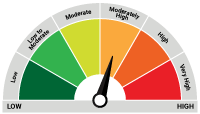Q&A with Chirag Mehta
Posted On Monday, Nov 20, 2017
Mr. Chirag Mehta, Sr. Fund Manager-Alternative Investments answers some questions on Quantum Multi-Asset Fund (QMAF) and shares his insights on why is it a good idea to invest in Quantum Multi Asset Fund.
1. Tell us more about the Quantum Multi Asset Fund - what is it invested in, how is it split?
The Quantum Multi Asset Fund (QMAF) offers investors a comprehensive portfolio solution by integrating allocations to equities, fixed income and gold in an effort to generate modest capital appreciation while carrying moderately high risk. The optimal allocations depend on a research-backed investment process. The fund follows a dynamic portfolio allocation technique which means that the asset allocation changes depending on an asset class's relative valuation vis-á-vis other asset classes. The fund allocates dynamically and has a broad mandate with units of equity schemes and debt schemes allocations ranging from 25-65% and units of gold scheme from 10-20% and Money Market & Short Term Debt securities 0-5%. As far as the current allocations go, QMAF has been reducing exposure to equities as it keeps moving higher - it has gradually reduced exposure to equities from 45% to 35% now. As far as current allocations go, equities are around 35%, debt around 50% and gold around 15%.
2. Having 3 asset classes means factoring in the risk associated with 3 classes instead of two. How would you explain this?
While no "perfect" portfolio exists, many investors will find that a sensible approach incorporates diversification across multiple sources of risk and return. This process is simply known as asset allocation. Asset allocation is an excellent tool for addressing the volatility of investment markets. Despite their higher individual risk, risky assets can combine together in a diversified portfolio and yield the target results for every investor: lower portfolio risk, higher returns. The Quantum Multi Asset Fund diversifies across three asset classes, amongst which debt and Gold are negatively correlated to equities (which are relatively more volatile), so this helps in further reducing the risk rather than enhancing.
3. The BSE Sensex has been soaring up till this past week. How are you approaching the allocation of the portfolio? [Given QLTEF is underperforming.]
As equities have continued to become expensive, we have reduced exposure to the asset class. On a relative basis, the decline in bond yields has helped equities from a relative valuation perspective. Despite that, equities do look expensive and we have been reducing our exposure. If there is any further run up in equities, we would further reduce our exposure and increase exposure to debt and gold. Within the equity allocation, despite the near term poor performance of the Quantum Long Term Equity Fund (QLTEF), we have continued to reduce exposure to Quantum Nifty ETF (QNF) and retained our allocation to QLTEF. As market valuations get stretched, QLTEF is trying to reduce risk by staying out of markets as there is dearth of good opportunities in this liquidity-driven frothy market we currently see. Therefore it helps QMAF to reduce risk further and contributes towards its objective of risk mitigation. Within the debt segment, we've seen a good rally in bonds which we have used to gradually reduce our exposure to the bond fund while increasing exposure to the liquid fund.
4. Since recommended asset allocation differs with age, which age group would you recommend QMAF to? Why?
It's not about age, it's about the objective. Any investor who finds that an investment objective of moderately high risk and modest returns fits with their financial goals should look at QMAF. This would mainly coincide with investors who are moving closer to retirement or retirees who cannot afford to take high risk, but are ok with some amount of risk to earn an additional return over fixed income. It also fits the young who are looking to, say, buy a house and are saving for it. Those investors who can bear a little volatility for that additional return in order to get themselves closer to their goals can look at QMAF.
5. Why should an investor deal with a fund like this that's subject to debt taxation rules rather than equity, which has no capital gains tax after a year?
Equities as an asset class have the potential for high returns. At most times, we tend to forget that these high returns are associated with high risk. Tax advantages do not help counter the potential risk of capital erosion. Therefore, in order to balance the risks, allocation among asset classes is critical in structuring a successful portfolio. Since it's impossible to predict the future or determine the next best-performing asset class, asset allocation increases the odds of having a portion of your assets "in the right place at the right time." Asset allocation is important because it has major impact on whether you will meet your financial goal. If you don't include enough risk in your portfolio, your investments may not earn a large enough return to meet that goal. For example, if you are saving for a long-term goal, such as retirement or higher education for your children, most financial experts agree that you will likely need to include at least some equities or equity mutual funds in your portfolio. On the other hand, if you include too much risk in your portfolio, the money for your goal may not be there at the time when you need it, so make sure you allocate risk properly given your particular situation.
6. What is the approximate rate of return one can expect from QMAF over the long term?
As stated upfront in the investment objective, the fund aims to generate modest capital appreciation and with moderately high risks. To put it in a layman's terms, we endeavor to generate returns of a few percentage points more than the traditional investment avenues like fixed deposit. However, we believe that the returns could get augmented as markets go through cycles since the fund should be able to appropriately position itself to take advantage of market swings during these cycles.
7. What makes QMAF a conservative investment despite investing up to 40% in Equities?
QMAF positions the allocations based on market fundamentals as suggested by the valuation metrics it uses. The strategy focuses on lowering risk at all times. As equities get relatively expensive, despite the fund moving higher, it will not be afraid to reduce its allocation to equities. And this focus on reducing risks leads to lower volatility of the fund, thereby making it a more conservative investment. It aims to back itself on fundamental calls; in fact, at appropriate times the fund could be even as high as 65% in equities (but no higher). However, such a high allocation would be at a level when equities are extremely cheap, implying little long-term downside. The fund's focus on fundamentals, diversification and above all an emphasis on reducing risks at all times results in lower volatility, thus making it more of a conservative investment.
| Name of the Scheme & Primary Benchmark | This product is suitable for investors who are seeking* | Risk-o-meter of Scheme |
| Quantum Multi Asset Fund of Funds (An Open Ended Fund of Funds Scheme Investing in schemes of Quantum Mutual Fund) | • Long term capital appreciation and current income • Investments in portfolio of schemes of Quantum Mutual Fund whose underlying investments are in equity , debt / money market instruments and gold |  Investors understand that their principal will be at Moderately High Risk< |
* Investors should consult their financial advisers if in doubt about whether the product is suitable for them.
Disclaimer, Statutory Details & Risk Factors:
The views expressed here in this article / video are for general information and reading purpose only and do not constitute any guidelines and recommendations on any course of action to be followed by the reader. Quantum AMC / Quantum Mutual Fund is not guaranteeing / offering / communicating any indicative yield on investments made in the scheme(s). The views are not meant to serve as a professional guide / investment advice / intended to be an offer or solicitation for the purchase or sale of any financial product or instrument or mutual fund units for the reader. The article has been prepared on the basis of publicly available information, internally developed data and other sources believed to be reliable. Whilst no action has been solicited based upon the information provided herein, due care has been taken to ensure that the facts are accurate and views given are fair and reasonable as on date. Readers of this article should rely on information/data arising out of their own investigations and advised to seek independent professional advice and arrive at an informed decision before making any investments. Please visit – www.quantumamc.com/disclaimer to read scheme specific risk factors.
Related Posts
-

Gold Monthly for December 2025
Posted On Thursday, Dec 04, 2025
After a series of events and a strong rally in October 2025, gold demonstrated a mixed performance in November 2025, moving back and forth within a defined range.
Read More -

Equity Monthly for December 2025
Posted On Wednesday, Dec 03, 2025
Markets continued the rising trend in October with Sensex gaining 2.2%.
Read More -

Debt Monthly for December 2025
Posted On Tuesday, Dec 02, 2025
As we approach the end of the calendar year, we find ourselves at a pivotal moment, with the market split on the likelihood of an upcoming rate cut.
Read More



